This week our blog post is by Sophie Richards, our Fabric of India Exhibitions Assistant, who gives us some behind-the-scenes insight into what you hopefully won’t notice during your visit!
I’m Sophie, the Exhibitions Assistant on The Fabric of India. I haven’t contributed to the blog before, but I am in the background of several photos where it looks like I am playing on my phone – I promise I’m not! I’m photographing the object, or details of the mounting, to keep as a reference and to show to any members of the team who might not be present.
I spend a large amount of time at the moment discussing the mounting of the objects. Mounting is how we display the objects, how they are held in place or protected whilst in the exhibition, and it is something that has to be discussed for each of the 200+ objects in the show. Mounts should respond to the conservation needs of the object as well as the design aesthetic of the exhibition. Textiles, it transpires, are very high maintenance. Words like sympathetic are used, things must not put pressure on an object, it must never be stressed, it should be supported and comfortable. Sometimes it is necessary for a textile to be relaxed.
Sometimes this is as simple as placing a piece of Melinex (an inert transparent film) beneath an object as a barrier to isolate it from another material such as a table top. Other mounts involve scaffolding and ingenious ways of absorbing parts of the object that we don’t have room to display.
Different exhibitions and different designers have different approaches to mounts, but frequently, and this is the case with The Fabric of India, the preference is for mounts to be inconspicuous – invisible if at all possible. This post aims to break something of that fourth wall and let you in on the discussions we have on the details that ideally, no-one will notice. Disclosure – since I began working on exhibitions and displaying collections I now can’t go into a gallery without seeing the mounts when I see the objects. This is the sort of thing that once it’s pointed out to you, you can’t ‘un-see’ it. So if you want the mounts to stay invisible, stop reading NOW.
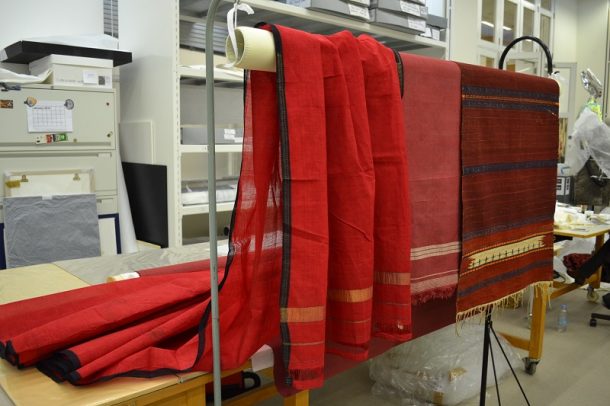
In this post I’m going to focus on rollers – there will hopefully be a follow up post on some of the larger, more challenging mounts soon to come.
There will be loads of rollers in The Fabric of India. They are one of the ways of displaying fabric from a wall that allows the fabric to hang and drape whilst supported. This is an image of a roller in action in one of our mock ups, followed by a close up of the roller end.
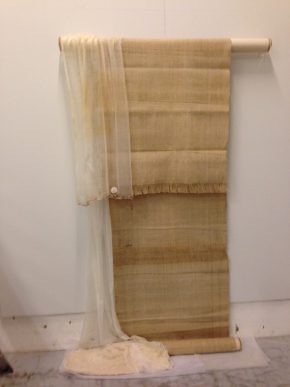
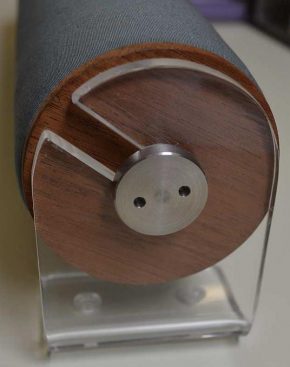
We use cardboard rollers, these look like oversized kitchen roll tubes. These are covered with Melinex film, polyester padding and then with a display fabric. As part of the design process Gitta (our exhibition designer)chose fabrics that matched the walls of the different exhibition spaces. You can read more on about this process in this earlier post.
At the end of the roller is a solid circle ‘stopper’, most of this will be covered by the brackets, but it still has to be considered. It can be made from Perspex, wood, or metal, with each having pros and cons for the conservation, technical services, and design teams, who will be pouring over the samples below, to find an appropriate material and colour match. The same discussion happens for the brackets, which are subject to a different set of pros and cons. For those who are extra interested – Perspex, an inert material, easy to shape, but not a great variety of colours, vs metal, nice and thin, can be painted in a variety of shades, but the paint can scratch during installation.
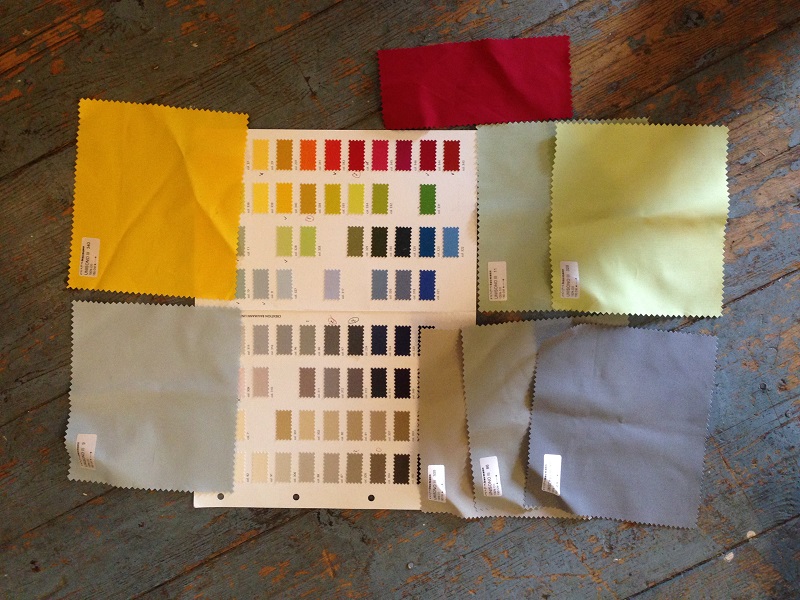
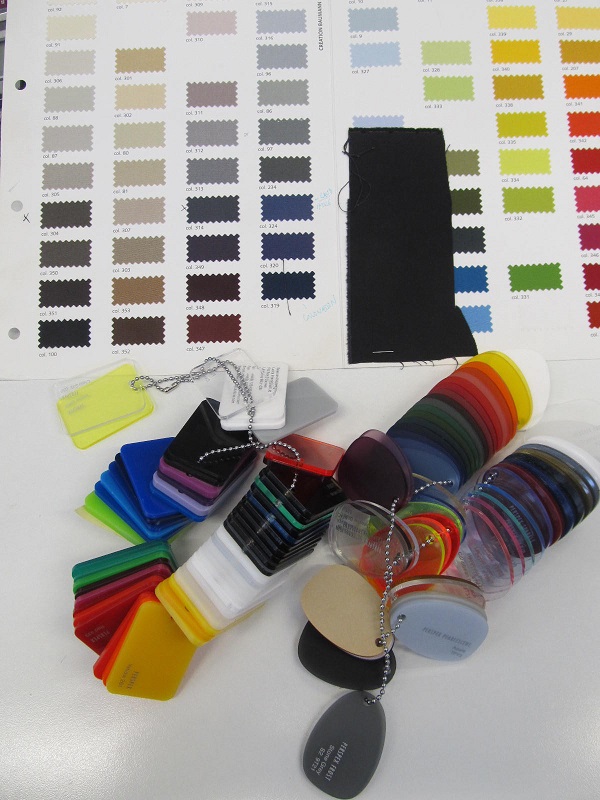
There are a couple of secrets to inconspicuous mounts. In the past transparent Perspex has been popular, but transparent doesn’t really mean ‘invisible’. The trick is to find not something that the eye can’t see, but something that it doesn’t. This can mean that it blends to its surroundings, like the roller fabric, or becomes part of a visual language within the exhibition space. Our starting point has been picking a colour for all of the supportive metalwork in the exhibition, this includes the brackets for the rollers, the bases of the mannequins and any other visible metal supports. The idea is that the colour complements the objects without stealing the show and that as it is used consistently around the objects, the visitor quickly becomes used to ignoring it and so no longer ‘sees’ anything in that colour. Gitta has chosen a dark grey, on its own it is not discrete, and it doesn’t blend with the bright wall colours, but in the low lighting of the exhibition space it disappears like a shadow around the splendour of the objects.
Rollers are pretty time consuming and bravo to the team of conservators and technicians who have been preparing them for the exhibition (you can see a growing pile in the image below), but in terms of mounts they are quite straightforward once all the details are chosen. I’m hoping to spend a future post introducing the challenges of mounting more complex objects.
In the meantime, next time you’re in an exhibition – spare a thought for the details that we’re hoping you won’t notice.

The exhibitions team will be posting again soon – next time on tackling the challenges of our largest objects (THEY’RE REALLY BIG!).
Hi
Really looking forward to visiting this exhibition, it looks glorious! I’m the Learning Officer for Huddersfield University Archives and came across it while searching for background information for a primary schools workshop I’m developing. The archives contain some fantastic 19th century Indian textile sample books which contain 700 working samples of cotton, silk and woollen textiles obtained from different parts of India.The idea was to give textile manufacturers specimens of all the important textile materials used by the people of India, plus their use, i.e. men’s wear, women’s wear, towels, rugs – and tents! It’s my role to engage schools with the collection, and I was thinking of a whole class activity where we all recreate a huge Indian tent. Reading about the forthcoming exhibition has made me even more determined to make it happen! I’m wondering what plans you have for schools workshops or learning resources to accompany the exhibition?
Hi Trizia,
Thanks so much for your comment about the exhibition and letting us know about your project for Primary Schools. Sounds Fantastic!
My name is Cara and I work in the Learning department here at the V&A. We have lots of activities and events planned for the exhibition.
We will be hosting a Teacher Twilight on 16 October, where teachers will be able to hear from the curators of the exhibition and pick up free teaching resources.
We are in the process of developing a resource for secondary students linked to the show and one for primary linked to the permanent display of Indian objects, which will also include information and activities linked to textiles and dress.
And finally, there are going to be some Schools Exhibition Mornings during the run of the show – these are exclusive time slots for schools so they can visit the exhibition to teach, sketch and draw. To find out more visit http://www.vam.ac.uk/content/articles/p/plan-a-free-self-guided-visit-for-primary-pupils/
To find out more about the India Season please visit http://www.vam.ac.uk/page/v/v-and-a-india-festival/
Best wishes,
Cara